
11 ALGEBRA
.pdf
Replacing these values in (1) gives us (m + 6) (m – 2) > 0
–m + 3 < 0,
from which we conclude m > 3. Similarly, (2) becomes (m + 6) (m – 2) = 0
m > 0,
which gives us m = 2. Therefore, 4x – (m 2x) – m + 3 = 0 has only one solution if m {2} (3, ).
Check Yourself 25
1. Determine all values of a for which the equation 9x + a (a + 1) = (2a + 1) 3x has a. no solution. b. only one solution. c. two solutions.
2.State the solutions of the equation 4x – 2m(m + 1) 2x – 1 + m3 = 0 in terms of the parameter m.
Answers |
|
|
|
|
|
|
|
1. |
a. (– , –1] |
|
|
b. (–1, 0] |
c. (0, ) |
||
|
{log2 m2 |
} |
for |
m (– , 0) |
|||
2. |
|
|
|
for |
m = 0 |
|
|
S = |
|
|
|||||
|
|
|
m, |
2 |
} for |
m (0, |
) |
|
{log2 |
log 2 m |
|||||
2. Exponential Inequalities
To solve simple exponential inequalities, we use the monotone property of exponential functions which we saw earlier in this module:
|
for |
a > 1, ag(x) > ah(x) |
g(x) > h(x), and |
|||
|
for |
0 < a < 1, ag(x) > ah(x) |
g(x) < h(x). |
|||
|
Notice that for a > 1 the directions of the inequalities are the same, but for 0 < a < 1 they |
|||||
|
are opposite. |
|
|
|
|
|
|
88 Solve the inequalities. |
|
|
|
|
|
EXAMPLE |
|
|
|
|
||
|
1 |
1 |
|
|||
|
|
|
|
|||
|
a. 24x < 16 |
b. 3x ( |
3)x – 3 |
( |
|
)x |
|
27 |
|||||
Solution a. We can write 24x < 16 24x < 24. Since the base (2) is greater than 1, the direction of inequality for the exponents will be the same: 4x < 4 x < 1.
So the inequality holds for x (– , 1).
Exponential and Logarithmic Functions |
199 |

A critical value of f(x) is a value of x which makes the expression f(x) = 0 true.
EXAMPLE 89
Solution
b. Rewriting the given inequality gives us
3x ( |
1 |
( |
1 |
|
|
3)x – 3 |
|
)x |
3x 33 – x 3–3x 3x+3 – x 3–3x 33 3–3x. |
||
27 |
Since the base is greater than 1, we can write 3 –3x which means –1 x. Hence, x (– , –1].
Check Yourself 26
Solve the inequalities.
|
|
|
|
2 |
|
( |
8 |
|
a. |
24x < 32 |
b. |
( |
3)2–2 x |
|
)x–2 |
||
27 |
||||||||
Answers |
|
|
|
|
|
|
|
|
a. |
(– , 5) |
b. |
(– , |
8] |
|
|
|
|
|
4 |
|
|
|
5 |
|
|
|
The examples above solve simple inequalities. To solve more complex inequalities, follow the steps:
1.Rewrite the inequality so that one side becomes zero: f(x) 0 or f(x) 0.
2.Solve f(x) = 0 for critical values of f(x).
3.Establish a sign table for f(x) with these critical values. To determine the sign for each interval, we place the sign of the leading coefficient in the rightmost interval and change the sign at each single root while moving left through the intervals. Alternatively, we can use a value of x from each interval to check the sign of the function in that interval.
4.Select the appropriate intervals as the solution set.
Let us look at some examples.
Solve the inequalities.
5x–1 |
|
b. 9x – 5 3x + 6 0 |
a. 42x–1 |
64 |
a.We follow the steps described above:
1. Considering that 64 = 43 and 4 > 1, we get
5x–1 |
43 |
5x – 1 |
3 |
5x – 1 |
– 3 0 |
|
5x – 1– 6x+3 |
0 |
|
– x+2 |
0. |
42x–1 |
|||||||||||
|
|
2x – 1 |
|
2x – 1 |
|
|
2x – 1 |
|
|
2x – 1 |
|
2. Find the critical values: –x + 2 = 0 x = 2 and 2x – 1 = 0 x = 21.
3.Since –x + 2 has a negative leading coefficient and 2x – 1 has a positive leading coefficient, the fraction in which they are numerator and denominator will have a negative leading coefficient. Therefore, when we draw the sign table, we start with a
negative sign in the rightmost interval and alternate as we move left.
|
|
|
|
|
1 |
|
|
|
x |
–¥ |
|
|
2 |
¥ |
|
|
2 |
||||||
|
|
|
|
|
|
|
|
–x + 2 |
|
– |
|
+ |
– |
||
|
|
|
|
|
|||
|
2x – 1 |
|
|
||||
|
|
|
|
|
|
||
200 |
Algebra 11 |

log32 < log33 log32 < 1
4. We select the interval (21 , 2] as the solution set for x, because it is the solution set of
–x+2 0, which implies that the fraction should be positive. 2x – 1
b. Let f(x) = 9x – 5 3x + 6. Factorizing f(x) gives us
f(x) = (3x)2 – 5 3x + 6 f(x) = (3x – 3) (3x – 2). If we solve f(x) = 0, we get
3x – 3 = 0 3x = 3 x1 = 1 and 3x – 2 = 0 3x = 2 x2 = log3 2. Let us establish a sign table with these values:
x |
–¥ |
log3 2 |
1 |
¥ |
||
f(x) |
|
+ |
|
– |
|
+ |
|
|
|
|
|
|
|
We can see that f(x) 0 if x [log3 2, 1].
EXAMPLE 90
Solution
af(x) < ag(x)
f(x) < g(x) if a > 1 f(x) > g(x) if 0 < a < 1
Check Yourself 27
Solve the inequalities.
a. |
25x < (6 5x) – 5 |
b. 4x – (2 25x) < 10x |
|
Answers |
|
|
|
a. |
(0, 1) |
b. (log 2 |
2, ) |
|
|
5 |
|
Find the value(s) of x which satisfy |x|x2–3x–4 < 1.
By definition, |x| 0 and we can exclude the case |x| = 0 as this would result in a negative exponent and therefore a division by zero (since 0–4 = 01–4 = 01). So we can write |x|x2–3x – 4 < 1 |x|x2–3x–4 < |x|0.
Now we have to check the cases 0 < |x| < 1 and |x| > 1 (for |x| = 1, the inequality will  be 1 < 1, which is false). In other words, we have to solve the systems
be 1 < 1, which is false). In other words, we have to solve the systems
0 <| x|<1
x2 – 3x – 4 > 0
|
| x|>1 |
|
and |
|
|
|
|
|
|
x2 |
– 3x – 4 < 0 |
|
|
|
–1< x <1 and x 0 |
|
|
no solution |
|
|
|
x< –1 or x> 4 |
|
|
x < –1 or x>1 |
|
|
x (1, 4). So the solution set is x (1, 4). |
|
|
–1< x < 4
Exponential and Logarithmic Functions |
201 |
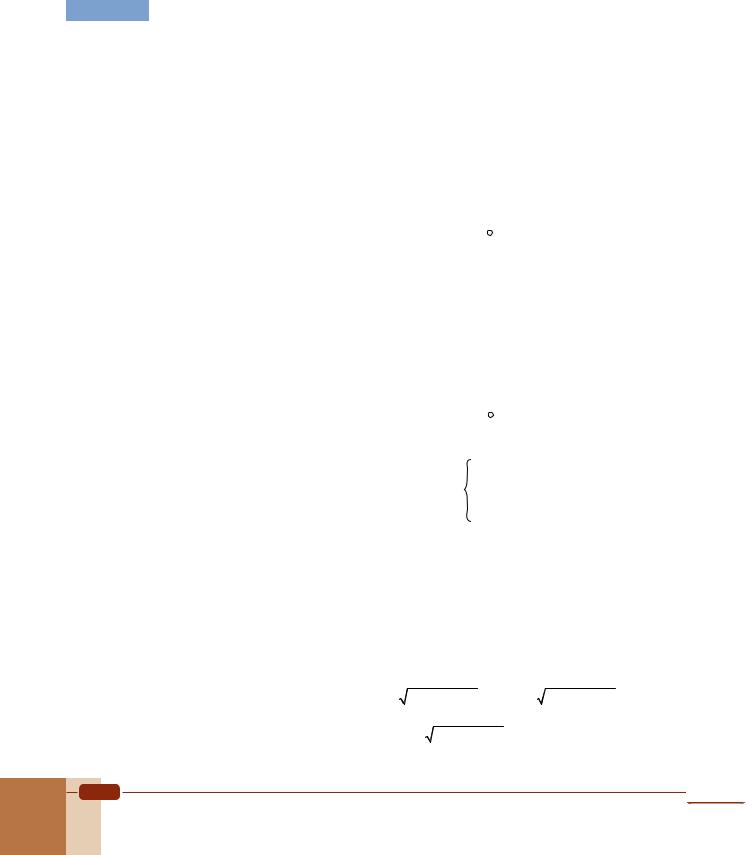
EXAMPLE 91
Solution
Solve the inequality a2 – 9x+1 – (8a 3x) > 0 for negative, zero and positive real values of a.
We begin by factorizing the left-hand side:
a2 – 9x+1 – (8a 3x) > 0 (9 9x) + (8a 3x) – a2 < 0 9 (3x)2 + (8a 3x) – a2 < 0 (3x + 2 – a) (3x + a) < 0.
Let us look at the solution to this inequality for each of the three different cases.
a > 0: If we try to find the critical values of the expression on the left-hand side, we get
(3x + 2 – a) (3x + a) = 0 |
(3x + 2) – a = 0 |
x = log |
|
a |
= –2 + log a. |
||||
|
|
|
|
|
|
3 9 |
3 |
||
Notice that 3x + a > 0. The corresponding sign table is therefore |
|
|
|||||||
|
|
–2 + log3 a |
|
|
|
|
|||
|
x |
–¥ |
|
|
|
¥ |
|||
|
(3x+2 – a) × (3x+ a) |
|
– |
|
+ |
|
|
|
|
|
|
|
|
|
|
|
|
|
|
As a result, (3x + 2 – a) (3x + a) < 0 if x (– , –2 + log3 a) for a > 0.
a = 0: Since both 3x+2 and 3x are positive, their product will be positive. So the inequality cannot be negative and therefore it has no solution when a = 0.
a < 0: Since 3x + 2 – a > 0, we conclude that 3x + a should be zero while finding the
critical value(s) of the product (3x + 2 – a) (3x + a). So we get the solution x = log3(–a) for (3x + 2 – a) (3x + a) = 0. The corresponding sign table is
|
x |
–¥ |
|
log3 (–a) |
¥ |
||
|
|
|
|
|
|
|
|
(3x+2 – a) × (3x+ a) |
|
– |
|
+ |
|
|
|
So, (3x + 2 – a) (3x + a) < |
0 if x (– , log (–a)) for a < 0. |
|
|
||||
|
|
|
|
3 |
|
|
|
|
|
|
|
x (– , log3 (–a)) when a < 0 |
|||
In conclusion, for a2 – 9x+1 – 8a 3x > 0, S = |
when a = 0 |
|
|
||||
|
|
|
|
x (– , –2 + log3 a) |
when a > 0. |
||
Check Yourself 28
1.Solve (x2 + x + 1)x < 1.
2.Solve 4x – a 2x + 3 – a 0 for different real values of the parameter a.
Answers
1. (– , –1)
|
|
|
|
|
|
|
|
|
|
|
|
|
|
|
|
|
|
|
|
|
0 |
|
|
|
|
|
|
|
|
2. |
|
a – |
a |
2 |
+4a – 12 |
|
|
||
S = |
|
, log2 |
|||||||
|
[log2 |
|
|
|
|
2 |
|
||
|
|
|
|
|
|
|
|
|
|
|
|
|
a+ |
2 |
+4a |
– 12 |
|
||
|
|
|
a |
] |
|||||
|
(– , log2 |
|
|
|
|
2 |
|
||
|
|
|
|
|
|
|
|
|
|
|
for |
a (– , 2) |
|
|
for |
a = 2 |
|
a+ a2 +4a – 12 |
] for |
a (2, 3) |
|
2 |
|||
|
|
||
|
for |
a [3, ) |
202 |
Algebra 11 |

B. LOGARITHMIC EQUATIONS AND INEQUALITIES
1. Logarithmic Equations
An equation containing logarithms which have the variable in their base or argument (or both) is called a logarithmic equation. Here are some examples of logarithmic equations:
log2 x = 3, log2(x x+2)= 2, logx 3 + logx 9 = –3, logx(2x + 3) = 2. When solving logarithmic equations, we can use the following properties of logarithms:
1.loga(f(x) g(x)) = loga|f(x)| + loga|g(x)|
2.loga( gf((xx))) = loga|f(x)| – loga|g(x)|
3.loga f n(x) = n loga|f(x)|.
We must also remember that the argument of a logarithm is always positive, and its base is always positive and different from 1. As we have seen, these conditions are called the existence conditions for logarithms.
Just as we saw for exponential equations, there is no single method that we can use to solve all logarithmic equations. Instead, we can consider some common types of equation and their solution. As a general rule, after solving a given equation we always need to check which solutions satisfy the existence conditions in order to complete the solution.
a. Equations of the Form logf(x) g(x) = b
To solve an equation of this type, we can write it in exponential form using logf(x) g(x) = b f(x)b = g(x) and solve this new equation for x.
After finding the solution(s), we eliminate any values of x which do not satisfy the restrictions f(x) 0, f(x) 1, and g(x) 0 (by the existence conditions).
Let us look at some examples.
|
92 Solve the equations. |
|
|
|
|
EXAMPLE |
|
|
|
||
|
|
|
c. log3(5x2 – 9x + 7) = 2 |
||
|
a. log2(3x – 1) |
= 3 |
b. logx + 1 16 = 2 |
||
Solution a. log2(3x – 1) |
|
|
|||
= 3 3x – 1 = 23 3x = 9 |
x = 3 |
|
|||
By the existence conditions, since x = 3 satisfies 3x – 1 > 0 it is the solution of the given logarithmic equation.
b.logx+1 16 = 2 (x + 1)2 = 16 x + 1 = 4 x1 = 3 or x2 = –5
Check against the existence conditions: we need x + 1 > 0 and x + 1 1, so we accept only x = 3 as the solution since x = –5 does not satisfy x + 1 > 0.
Exponential and Logarithmic Functions |
203 |
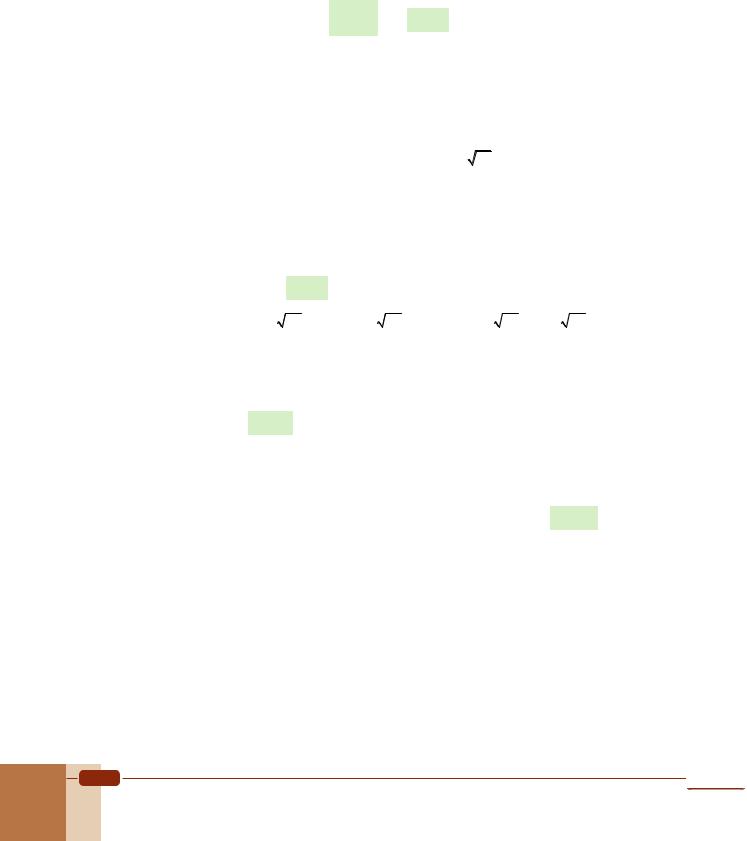
c.log3(5x2 – 9x + 7) = 2 5x2 – 9x + 7 = 32 5x2 – 9x – 2 = 0 (5x + 1) (x – 2) = 0
Accordingly, we get x1 = – 51 and x2 = 2 as possible solutions. Checking for 5x2 – 9x + 7 > 0, we decide that both solutions satisfy the inequality. So the solution set is S ={– 51, 2}.
|
93 Solve the equations. |
|
|
|
|
|
|
||
EXAMPLE |
|
|
|
|
|
|
|||
|
|
|
|
|
|
|
|||
|
a. log |
(3x2 |
– 3x + 4) = 2 b. |
log |
(log |
5 |
5x)= 0 |
c. log |
(3 – x) + log (1 – x) = 3 |
|
2x |
|
|
1 |
|
|
2 |
2 |
|
|
|
|
|
5 |
|
|
|
|
|
Solution a. log |
(3x2 |
– 3x + 4 ) = 2 (2x)2 |
= 3x2 – 3x + 4 x2 |
+ 3x – 4 = 0 |
|||||
|
2x |
|
|
|
|
|
|
|
|
(x + 4) (x – 1) = 0 x1 = –4 and x2 = 1
If we check these solutions for the conditions 2x > 0, 2x 1 and 3x2 – 3x + 4 > 0, we find that x1 = –4 does not satisfy 2x > 0. Therefore we eliminate it, and so the only solution is x = 1 .
b. log 1 |
(log5 5x)= 0 |
log 5 5x =( |
1)0 |
log5 |
5x =1 |
5x = 51 x= 5 |
5 |
|
|
5 |
|
|
|
|
|
|
|
|
|
|
The existence conditions state that we must have |
|
|||||
|
5x 0 and |
log5 ò5x 0. |
|
|
|
|
When x = 5, 5x = 25 0 and log5 ò5x = log5 ó5 5 = log5 5 = 1 0 and so we conclude that x = 5 is the solution of the equation.
c. log2(3 – x) + log2(1 – x) = 3 log2[(3 – x) (1 – x)] = 3 x2 – 4x + 3 = 23 x2 – 4x – 5 = 0 (x – 5) (x + 1) = 0 x1 = –1 and x2 = 5
Checking for the conditions 3 – x > 0 and 1 – x > 0, we conclude that x = 5 does not satisfy either condition. Therefore we eliminate it. Since x = –1 satisfies both conditions, it is the only solution to the given equation.
Check Yourself 29
Solve the equations.
a. log3(5x + 2) = 3 |
b. |
logx–1 49 = 2 |
c. log2x2+1 81 = 4 |
||
d. logx+1(x2 – 3x + 1) = 1 |
e. |
log 1 (log 1 |
(x+1))= –1 |
|
|
|
|
3 |
2 |
|
|
Answers |
|
|
7} |
|
|
a. {5} b. {8} c. { 1} |
d. {4} |
e. {– |
|
|
|
|
|
|
8 |
|
|
204 |
Algebra 11 |

b. Equations of the Form logf(x) g(x) = logf(x) h(x)
Since logarithmic functions are one-to-one, we can write logf(x) g(x) = logf(x) h(x) g(x) = h(x).
Therefore, to solve an equation of the form logf(x)g(x) = logf(x)h(x), we solve the equation g(x) = h(x) for x and then check the solutions for the restrictions f(x) 0, f(x) 1, g(x) 0 and h(x) 0.
EXAMPLE 94 Solve the equations.
a. |
log 1 |
x+2 |
= log 1 |
2 |
|
|
|
|
b. log x+21+ log |
x – 21 =1+ log 2 |
||||||
10 |
x+1 |
|
|
|
||||||||||||
|
5 |
5 |
|
|
|
|
|
|
|
|
|
|||||
|
|
|
|
|
|
|
|
|
|
|
|
|
|
|||
Solution a. |
log 1 |
x+2 |
= log 1 |
2 |
|
x+2 = |
2 |
|
x2 +3x – 18 = 0 |
|
||||||
10 |
x+1 |
x+1 |
|
|||||||||||||
|
5 |
5 |
10 |
|
|
|
|
|
|
|||||||
|
|
(x + 6)(x – 3) = 0 x1 = –6 and x2 = 3 |
|
|||||||||||||
|
These solutions must satisfy x+2 |
> 0, |
|
2 |
|
> 0 and x + 1 0. |
|
|||||||||
|
x+1 |
|
||||||||||||||
|
|
|
|
|
|
|
|
10 |
|
|
|
|
|
|
||
|
After checking, we eliminate x = –6 and take |
|
|
|||||||||||||
|
|
x = 3 |
as the solution. |
|||||||||||||
b. Simplifying the given equation gives us |
|
|
|
|
|
|
||||||||||
|
|
|
|
|
|
|||||||||||
|
|
log |
|
x+21+ log |
x – 21=1+ log 2 log( x+21 x– 21 )= log 10+ log 2 |
|||||||||||
|
|
log |
|
x2 – 212 = log(10 2) x2 |
– 441 = 20 x2 = 841 x = 29. |
|||||||||||
|
We eliminate x = –29 because it does not satisfy the condition |
x 21 > 0 . |
||||||||||||||
|
|
|
|
|
|
|
|
|||||||||
|
Therefore, |
x = 29 |
is the only solution for the given equation. |
|
||||||||||||
|
|
|
|
|
|
|
|
|
|
|
|
|
|
|
|
|
Check Yourself 30
Solve the equations.
a. log |
|
(x2 – 4x + 3) = log (3x + 21) |
b. log |
(x – 2) + log |
5 |
x = log |
5 |
8 |
||
3 |
|
|
3 |
5 |
|
|
|
|||
c. log |
|
x – 2 |
=1+ log |
3x – 7 |
|
|
|
|
|
|
|
2 x – 1 |
|
2 3x – 1 |
|
|
|
|
|
|
|
Answers |
|
|
|
|
|
|
|
|
||
a. {–2, 9} |
b. {4} |
c. {3} |
|
|
|
|
|
|
||
Exponential and Logarithmic Functions |
205 |
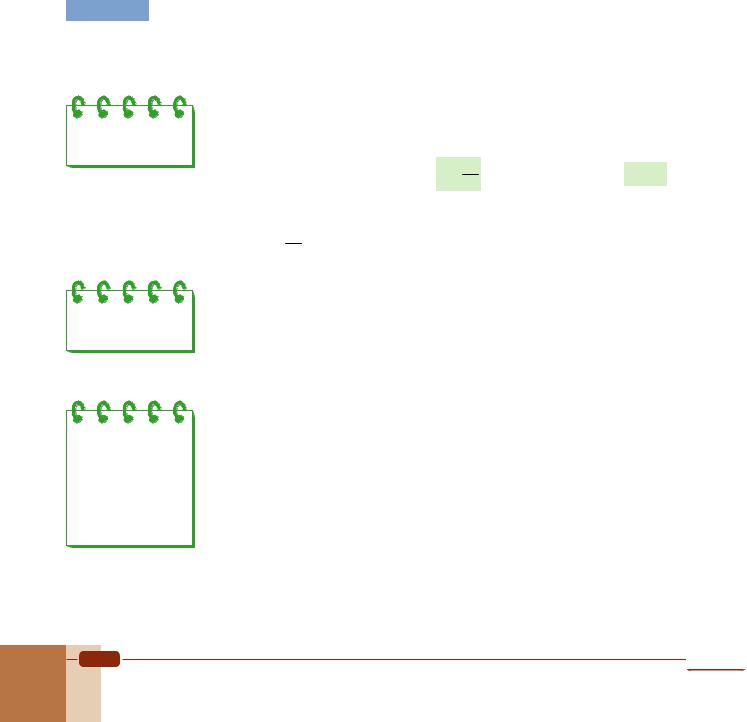
c. Working with Logarithmic Equations
|
|
If a logarithmic equation is not already in |
one of the two forms logf(x) g(x) = b or |
|||||
|
|
logf(x) g(x)= logf(x)h(x), we can sometimes rewrite it in one of these forms by using substitution |
||||||
|
|
and the laws of exponents. |
|
|
||||
|
|
Let us look at some examples. |
|
|
||||
EXAMPLE |
|
95 Solve the equations. |
|
|
|
|
||
|
|
a. |
log32 x+2 log3 x= 3 |
b. xlog3 x = 3 |
c. log2(12 – 2x) = 5 – x |
|
||
Solution a. Substituting log3 x = y gives us a quadratic equation: |
|
|||||||
|
|
|
log 2 |
x+2 log |
3 |
x = 3 y2 + 2y – 3 = 0 (y + 3)(y – 1) = 0 y = –3 and y = 1. |
||
|
|
|
3 |
|
|
1 |
2 |
|
loga2 x = log a x log a x |
We then solve log3x = y for x with these values: |
|
||||||
log n x =(log |
a |
x)n |
|
|
|
|
|
|
a |
|
y = log3 x = –3 x = 3–3 x = 1 |
|
|
||||
|
|
|
and y = log3 x = 1 x = 3 . |
|
||||
|
|
|
|
|
|
27 |
|
|
|
|
|
Since both solutions satisfy the existence conditions for the given logarithms, the solution |
|||||
|
|
|
set is S ={ |
1 , 3}. |
|
|
|
|
|
|
|
|
27 |
|
|
|
|
loga xf ( x ) f ( x) log a x
When an exponential equation has logarithmic expressions in an exponent, we can take logarithms of both sides to a suitable base in order to get the exponents as factors.
b.By the one-to-one property of logarithms, we can take logarithms of both sides to base 3 (notice that both sides are positive):
xlog3 x = 3 log3(xlog3 x )= log 3 3 (log 3 x)(log 3 |
x)=1 |
|
|
|
|
|
|||||
|
|
|
|
|
|
|
|
||||
|
|
|
1 |
|
|
|
|||||
log32 x =1 log 3 x=1 or log 3 x= –1 |
x = 3 |
or |
x = 3–1 = |
|
. |
|
|
||||
3 |
|
|
|
||||||||
c. Converting the equation into exponential form gives us |
|
|
|
|
|
|
|||||
|
|
|
|
|
|
|
|||||
log (12 – 2x) = 5 – x 25 – x = 12 – 2x 2x + 25 |
– 12 = 0. |
|
|
|
|
|
|||||
2 |
|
|
|
2x |
|
|
|
|
|
|
|
|
|
|
|
|
|
|
|
|
|
|
|
Substituting y for 2x, we get |
|
|
|
|
|
|
|
|
|||
y+ 32 – 12 = 0 y2 – 12y + 32 = 0 (y – 8)(y – 4) = 0 y1 = 8 and y2 = 4. |
|||||||||||
y |
|
|
|
|
|
|
|
|
|||
Since both values are positive, we solve |
|
|
|
|
|
|
|
|
|||
|
|
|
|
|
|
|
|
||||
y = 2x = 8 2x = 23 |
x = 3 |
and y = 2x = 4 |
2x = 22 |
x = 2 |
. |
||||||
|
|
|
|
|
|
|
|
|
|
|
|
Both values of x satisfy the condition 12 – 2x >0, so the solution set is S = {2, 3}.
206 |
Algebra 11 |
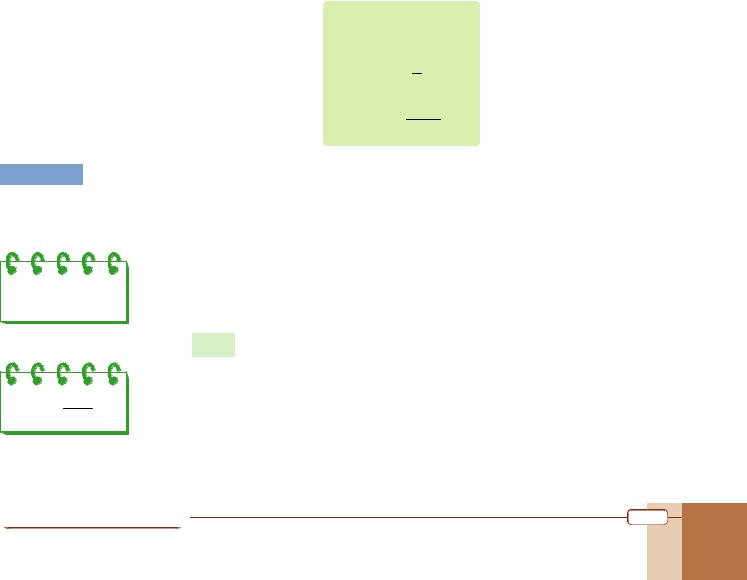
Check Yourself 31
Solve the equations.
a. log2(9 – 2x) = 3 – x b. xlog3 3x = 9 c. x2+log 2 x = 256 d. log2(9x–1 + 7) = 2 + log2(3x–1 + 1)
Answers |
b. {1 |
|
|
1 |
|
|
a. {0, 3} |
, 3} |
c. { |
, 4} d. {1, 2} |
|||
|
||||||
|
9 |
|
16 |
|
||
d. Equations with Logarithms to Different Bases
In order to work easily with logarithms, we need to have them to the same base. We can use the following properties of logarithms to help us:
For a, b, c 0 and a, c 1,
EXAMPLE 96
Solution
logan xm = mn log a x
loga x = log1x a
1. |
loga c = |
1 |
|
|
|||
logc a |
|||
|
|
2.logan x = n1 log a x
3.loga b = logc b. logc a
Solve the equations. |
|
a. log2 x + log8 x = 8 |
b. (3 logx 4) + (2 log4x 4) + (3 log16x 4) = 0 |
a. Let us write the second logarithm in base 2:
log2 x+ log8 x= 8 log 2 x+ log 23 x= 8 log 2 x+ 13log 2 x= 8 (1+ 13) log 2 x= 8 43 log 2 x = 8 log2 x = 6 x = 26 x = 64.
Since x = 64 satisfies the condition x > 0, it is the solution of the given equation.
b.We need to equalize the bases using the properties given above. Since all the logarithms have 4 as their arguments, we can write
3 logx 4+2 |
log 4x 4+3 |
log16x 4 = 0 |
(3 |
|
|
1 |
)+(2 |
1 |
)+(3 |
1 |
|
)= 0 |
|||||||||||
|
|
|
|
|
|
||||||||||||||||||
|
|
|
|
|
|
|
|
|
|
|
log4 x |
|
log4 4x |
|
|
log 4 16x |
|||||||
3 |
|
|
2 |
|
3 |
|
|
|
|
3 |
|
2 |
|
|
|
3 |
|
|
|||||
|
|
+ |
|
|
+ |
|
= 0 |
|
|
|
+ |
|
|
+ |
|
= 0. |
|||||||
|
log4 x |
log |
4 4+ log 4 x |
log 4 16+ log 4 x |
log 4 x |
1+ log 4 x |
2+ log 4 x |
||||||||||||||||
Exponential and Logarithmic Functions |
207 |
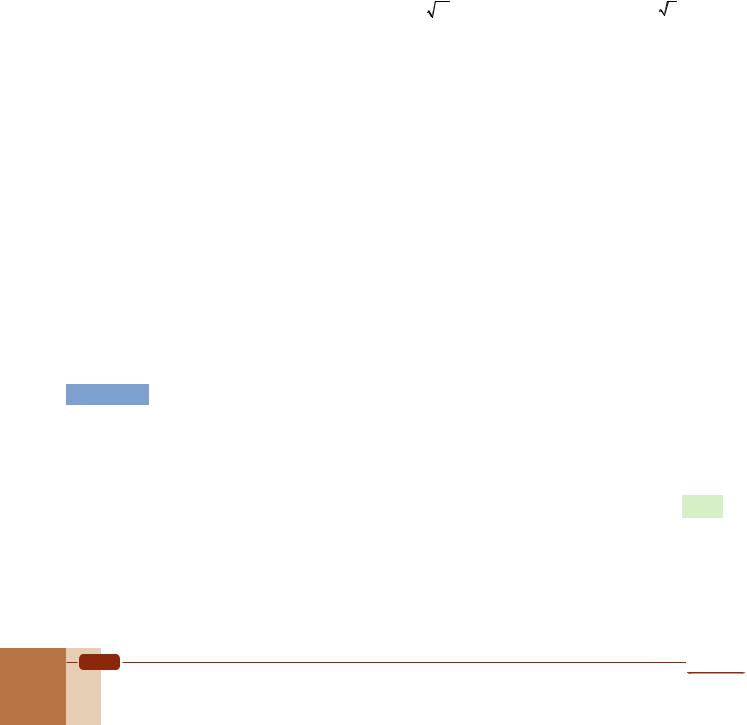
Substituting y = log4 x, we get |
|
|
|
|
|
|
|
||||||||||
3 + |
2 |
+ |
|
3 |
= 0 3(y + 1)(y + 2) + 2y(y + 2) + 3y(y + 1) = 0 |
|
|
|
|||||||||
|
|
|
|
|
|
||||||||||||
y |
y+1 |
y+2 |
|
|
|
|
|
|
|
|
|
|
|
||||
8y2 + 16y + 6 = 0 2(2y + 3)(2y + 1) = 0 y1 = – 3 |
and y2 = – |
1. |
|
|
|
|
|||||||||||
The corresponding values of x are |
2 |
|
2 |
|
|
|
|
||||||||||
|
|
|
|
|
|
|
|||||||||||
|
|
log4 x = y = – 3 |
3 |
1 |
|
1 and log4 x |
= – 1 x |
|
1 |
1 |
|
1. |
|||||
|
|
x = 4– 2 = |
= |
= 4– |
2 = |
= |
|||||||||||
|
|
4 |
|||||||||||||||
|
|
|
2 |
43 |
|
8 |
2 |
|
|
|
2 |
||||||
Since both |
|
x = 1 |
and |
x = 1 |
satisfy the conditions x > 0, x 1 4x 1, and 16x 1, the |
||||||||||||
|
|
|
|
8 |
|
2 |
1 |
1 |
|
|
|
|
|
|
|||
|
|
|
|
|
|
|
|
|
|
|
|
|
|
||||
solution set contains both solutions: S ={8 , |
2}. |
|
|
|
|
|
|
||||||||||
Check Yourself 32
Solve the equations. |
|
|
|
5 |
|
|||||
a. 2 log |
|
x + log |
ñ2 |
x + log |
x = 9 |
b. log 2 |
x + log |
= 1 |
||
|
2 |
|
|
|
1/2 |
5 |
|
5x x |
|
|
Answers |
1 |
|
|
|
|
|
|
|
||
a. {8} |
|
b. { |
, 1, 5} |
|
|
|
|
|
||
|
25 |
|
|
|
|
|
||||
|
|
|
|
|
|
|
|
|
|
|
e. Logarithmic Equations with a Unique Solution
If we can identify that a given equation has a unique solution (for example: by using the monotony of functions, or by using an arithmetic or geometric argument), and if we observe that a particular value of the variable satisfies the equation, then we do not need to look for another solution.
EXAMPLE 97 Solve the equations. |
|
a. log3 x = 4 – x |
b. 3log2(x – 2) – 2log3(x+2) = 5 |
Solution a. We can observe that x = 3 satisfies the equation, since log3 3 = 4 – 3 = 1.
In addition, since the left-hand side of the given equation is strictly increasing and the righthand side is strictly decreasing, we can conclude that this solution is unique: x = 3 .
b.Let log2(x – 3) = a and log3(x + 2) = b. So 3a – 2b = 5. In addition, we can write
log2(x – 3) = a 2a = x – 3 2a + 3 = x and log3(x + 2) = b 3b = x + 2 3b – 2 = x,
which gives us 2a + 3 = 3b – 2, i.e. 3b – 2a = 5.
208 |
Algebra 11 |
